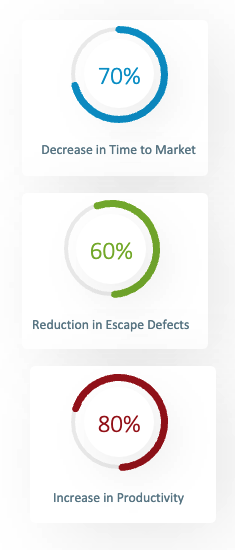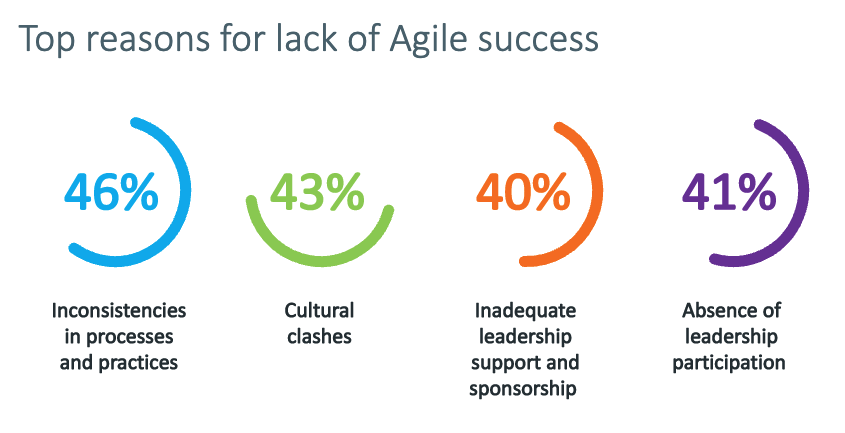Thirty years after the emergence of Agile, IT departments and businesses may be re-evaluating Agile and asking "Is Agile dead?" particularly if these organizations attempted Agile but did not implement it successfully. Yet many organizations – including Google, Facebook, Amazon, and Salesforce – have reaped Agile's rewards, including shortened cycle times, optimized value delivery, increased effectiveness, and reduced costs.
To explore why some organizations get better results from Agile than others, James Sweet, Agile Delivery Lead at Eliassen Group, and Dean MacNeil, Head of Agile at Scale Practice at Valiantys, delivered a webinar demonstrating that Agile is still very much alive, and they also give 7 tips on what you can do to enhance your Agility – starting today.
What Agile Is – and What It Isn't
MacNeil began the talk by diving into the root meaning of the word "Agile," which derives from the Latin agilis, meaning "nimble and quick." Sweet expanded upon MacNeil's etymology by noting that Agile is a mindset – not a process or methodology. Based on a set of values and principles that serve as guidelines, Agile can be manifested through an unlimited number of practices and can even coexist with Waterfall in some cases. "With values and principles," Sweet said, "there is no methodology or process. It really is a set of guardrails and guidelines that help us make critical decisions."
Then MacNeil shared what Agile is not. Following Sweet's statement that Agile is more of a mindset, MacNeil emphasized that Agile is not, among other things, a process, a methodology, or command and control. He said, "The thoughts, actions, and behaviors that got you where you are today won't get you where you need to go to remain competitive." The history of business is full of examples of companies that did not embrace an Agile mindset, felt that it was best to keep doing what they were doing, and were not able to keep up with the changing landscape. Sweet added, "Lean and Agile mindsets allow us to look at what's coming down the pike .... It allows us to respond to that and be a little bit forward-thinking and maybe even do some disruption."
Successful Agile – Fact or Fantasy?
To demonstrate Agile's success, MacNeil showed the results of the 2021 Digital.ai State of Agile Report. For example, respondents reported a 66% increase in business/IT alignment, which helps break down silos across an organization. Sweet added some statistics he had gathered from working with Eliassen Group clients:

Who Succeeds and Who Doesn't
After sharing these statistics that reflect Agile success, Sweet pointed out that if you are a member of the Agile community, you may have encountered the opposite view based on the following reasons:
- Most Agile adoptions struggle to produce real results.
- Many organizations suffer from "change fatigue."
- Agile is seen as the "buzzword of the month."
- It still takes too long and costs too much to deliver solutions.
Sweet admitted that not everyone enjoys an Agile success story: "All of these promises of better, stronger, faster, don't necessarily come to pass or come to fruition for organizations that are implementing Agile."
Although the 2021 Digital.ai State of Agile Report demonstrated Agile successes, respondents also shared their top reasons for the lack of Agile success:

Reasons for the lack of Agile success can involve inconsistencies in processes and practices, but they can also involve culture. MacNeil quoted Peter Drucker's famous statement: "Culture eats strategy for breakfast." But leadership isn't off the hook, as other reasons for the lack of Agile success involve inadequate or absent leadership.
Sweet added that MacNeil's last two points about leadership are key because "leadership often thinks that Agile is something that's done 'over there.' That's just putting lipstick on the business-as-usual pig.... what got you where you are today isn't going to get you where you need to go in the future." To achieve the full benefit of the Agile way of working, Sweet noted, leadership must be fully engaged and willing to change "the way they think, talk, and act about the work that we're doing." Otherwise, the organization will miss out on everything Agile has to offer.
But why wouldn't organizations be willing to change, especially if something isn't working? Sweet said that, based on his experience, "organizations are slow, bureaucratic, and broken." Even before COVID, "turbulent change is a matter of course," and the ability to identify opportunities and threats and react accordingly can make all the difference. The last reason is that narrow margins, driven by the need for efficiency and cost containment, can be the difference between thriving and languishing.
MacNeil returned to the matter of culture change as a key element of Agile success; otherwise, as Edgar Schein said, "If you do not manage culture, it manages you." Sweet referred again to the role of leadership in managing that culture and actually leading Agile adoption. Leadership must understand why the organization is adopting Agile, as they are the only ones with the authority to change and continuously improve the systems that govern how work is performed. Sweet said, "Leadership's got to embrace it, embody it ... they've got to model it as well."
With leadership's backing and a supportive culture, it is more likely for an organization to achieve the goal of what MacNeil described as the "Connected Enterprise." MacNeil described this state as when "people, work, time, and outcomes are connected, from top-level strategy to low-level execution," resulting in "one cohesive, mission-driven enterprise, with all things connecting to the mission."
Tools That Can Help You
MacNeil shared his experiences with the Jira Align tool to help reach the stage of the connected enterprise, but he said, "There are underlying principles and practices no matter what tool you're going to implement.... No matter what the tool is, it's only as good as your underlying data, organizational structures, and Agile practices that it visualizes and supports."
Another element of a successful tool is that it helps your organization keep everything – missions, visions, all the way down to objectives – interconnected and visible. Using a tool can make all work visible so everyone on the team understands why what they're doing matters, which enables them to make better decisions, avoid orphan work that is disconnected from strategy, and align their work with the objectives of the organization. This type of change can reap rewards. For example, Sweet shared a scenario in which a business unit of an organization implemented a tool along with lean portfolio management and saved $4 million annually in the process.
MacNeil's last reason for using a tool is that it makes it easier to focus on outcomes over outputs. For example, you could use an objectives and key results (OKR) heatmap and then click in to see details about how well you're achieving your goals and objectives. Capturing these metrics and visualizing them, Sweet added, leads to the greatest power of Lean-Agile, which is to shine the light of transparency on where you have problems, and then you can decide how to proceed. Sweet noted, however, that "with great power comes great responsibility," so it is wise to start with the minimum set of metrics to show that you are achieving your outcomes so you capture the most meaningful data.
7 Ways to Enhance Your Agility
After making the case for Agile and tooling, MacNeil and Sweet broke down clear-cut ways for organizations to get the most out of Agile:
- Embrace Agile as a leader and model the behavior: Leaders MUST not merely agree with but engage with and lead Agile adoption because they have the authority to change and continuously improve the way of doing work.
- Create and socialize a compelling "Why": If you don't know why you are adopting Agile, you’ll never be able to achieve real agility. Raise your hand and ask "why" so you can have an objective that you're working toward.
- Organize people around value/customer solutions: Matrixed and siloed organizations are incredibly inefficient. Organizing people around solutions creates significant efficiencies.
- Shift to outcomes over outputs: Rather than defining success by measuring outputs – hours worked, story points, or tasks completed – we want to focus on achieving a specific outcome with the least possible output.
- Demonstrate working product early and often: Showing working product also helps keep those who are doing the work and those who are asking for the work in sync.
- Decentralize decision-making: Shifting authority to where the information is – with the people doing the work – reduces bottlenecks and results in faster delivery and higher quality.
- Eradicate wasteful silos and hierarchies: Organizational siloes and needless hierarchies are the enemy of effectiveness, especially in product development. Working to lean out and eradicate these sources of waste is critical to Agile adoption and success in general.
Understanding the state of Agile today can help organizations develop the skills to adapt to the future. MacNeil and Sweet offered advice to help individuals introduce or advocate for Agile within their companies. As you are getting off the ground, if you need any help, feel free to turn to Valiantys or Eliassen's Agile Consulting Services, who can step in to assist you as you work your way toward the Connected Enterprise.
.png)


